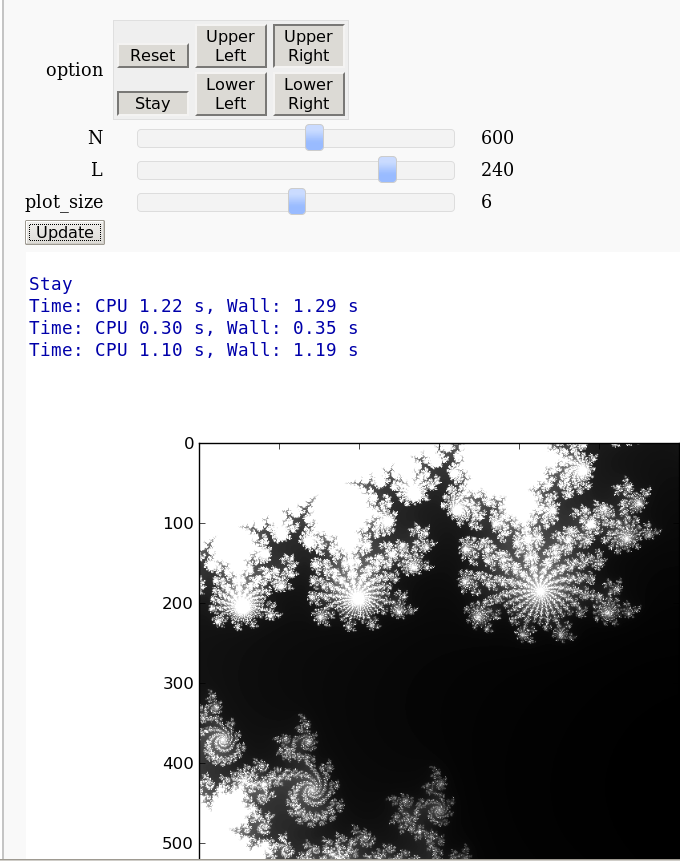|
Size: 3900
Comment: added "Exploring Mandelbrot"
|
Size: 3944
Comment: added cdef for speed
|
| Deletions are marked like this. | Additions are marked like this. |
| Line 131: | Line 131: |
| cdef complex c,z cdef int h, i, k |
Sage Interactions - Fractal
goto interact main page
Contents
-
Sage Interactions - Fractal
- Mandelbrot's Fractal Binomial Distribution
- Fractals Generated By Digit Sets and Dilation Matrices (Sage Days 9 - Avra Laarakker)
- Attempt at Generating all integer vectors with Digits D and Matrix A (How about vector([0,-1])?)
- Demonstrating that the Twin Dragon Matrix is likely to yield a Tiling of a Compact Interval of R^2 as k->infinity (It does!)
- Now in 3d
- Exploring Mandelbrot
Mandelbrot's Fractal Binomial Distribution
def muk_plot(m0,k):
"""
Return a plot of the binomial fractal measure mu_k
associated to m0, 1-m0, and k.
"""
k = int(k)
m0 = float(m0)
m1 = float(1 - m0)
assert m0 > 0 and m1 > 0, "both must be positive"
v = [(0,0)]
t = 0
two = int(2)
delta = float(1/2^k)
multiplier = float(2^k)
for i in [0..2^k-1]:
t = i * delta
phi1 = i.str(two).count("1")
phi0 = k - phi1
y = m0^(phi0)*m1^(phi1)*multiplier
v.append((t,y))
v.append((t+delta,y))
return v
html("<h1>Mandelbrot's Fractal Binomial Measure</h1>")
@interact
def _(mu0=(0.3,(0.0001,0.999)), k=(3,(1..14)), thickness=(1.0,(0.1,0.2,..,1.0))):
v = muk_plot(mu0,k)
line(v,thickness=thickness).show(xmin=0.5, xmax=0.5, ymin=0, figsize=[8,3])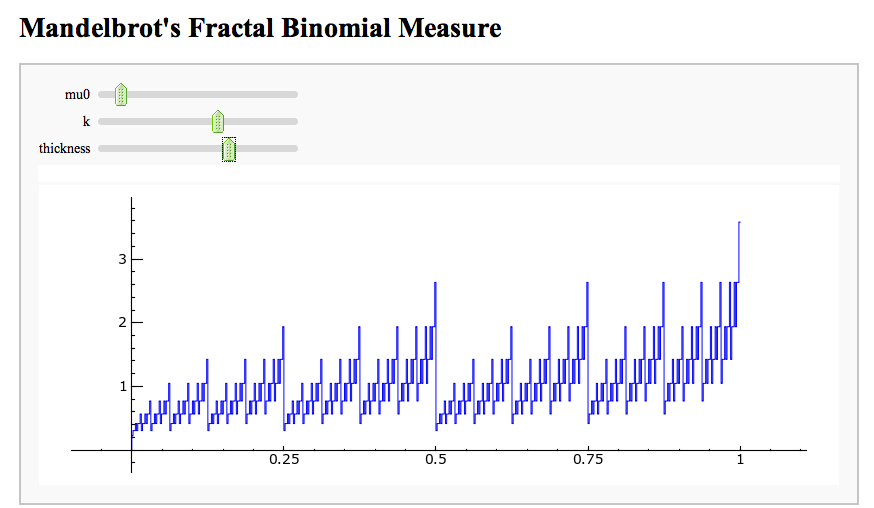
Fractals Generated By Digit Sets and Dilation Matrices (Sage Days 9 - Avra Laarakker)
Attempt at Generating all integer vectors with Digits D and Matrix A (How about vector([0,-1])?)
A = matrix([[1,1],[-1,1]])
D = [vector([0,0]), vector([1,0])]
@interact
def f(A = matrix([[1,1],[-1,1]]), D = '[[0,0],[1,0]]', k=(3..17)):
print "Det = ", A.det()
D = matrix(eval(D)).rows()
def Dn(k):
ans = []
for d in Tuples(D, k):
s = sum(A^n*d[n] for n in range(k))
ans.append(s)
return ans
G = points([v.list() for v in Dn(k)])
show(G, frame=True, axes=False)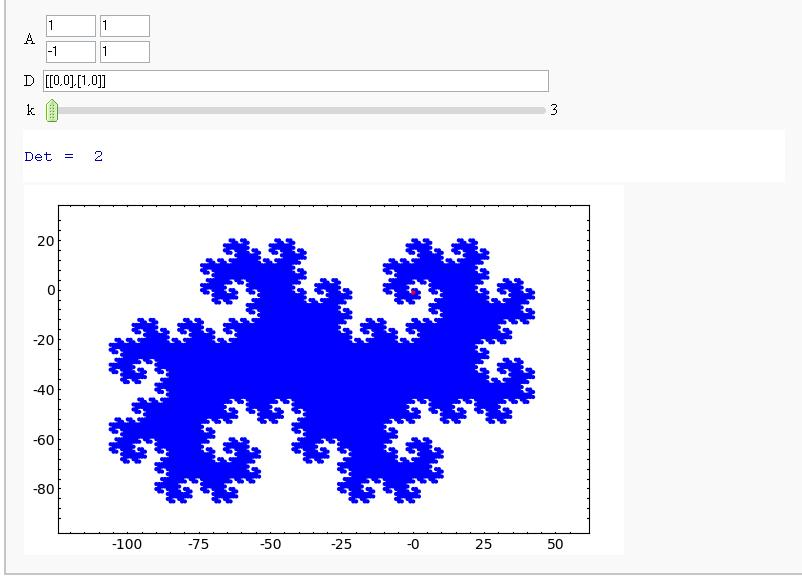
Demonstrating that the Twin Dragon Matrix is likely to yield a Tiling of a Compact Interval of R^2 as k->infinity (It does!)
A = matrix([[1,1],[-1,1]])
D = [vector([0,0]), vector([1,0])]
@interact
def f(A = matrix([[1,1],[-1,1]]), D = '[[0,0],[1,0]]', k=(3..17)):
print "Det = ", A.det()
D = matrix(eval(D)).rows()
def Dn(k):
ans = []
for d in Tuples(D, k):
s = sum(A^(-n)*d[n] for n in range(k))
ans.append(s)
return ans
G = points([v.list() for v in Dn(k)])
show(G, frame=True, axes=False)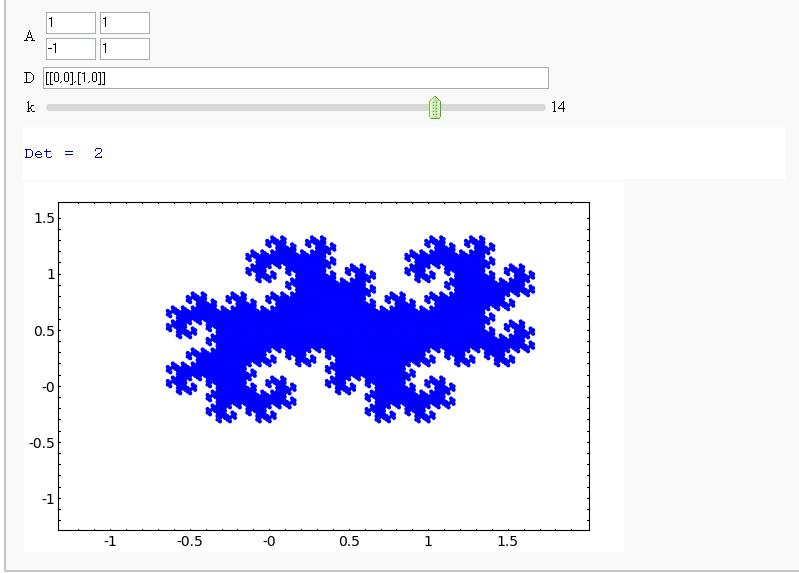
Now in 3d
A = matrix([[0,0,2],[1,0,1],[0,1,-1]])
D = '[[0,0,0],[1,0,0]]'
def Dn(D,A,k):
ans = []
for d in Tuples(D, k):
s = sum(A^n*d[n] for n in range(k))
ans.append(s)
return ans
@interact
def f(A = matrix([[0,0,2],[1,0,1],[0,1,-1]]), D = '[[0,0,0],[1,0,0]]', k=(3..15), labels=True):
print "Det = ", A.det()
D = matrix(eval(D)).rows()
print "D:"
print D
G = point3d([v.list() for v in Dn(D,A,k)], size=8)#, opacity=.85)
if labels:
G += sum([text3d(str(v),v) for v in Dn(D,A,k)])
show(G, axes=False, frame=False)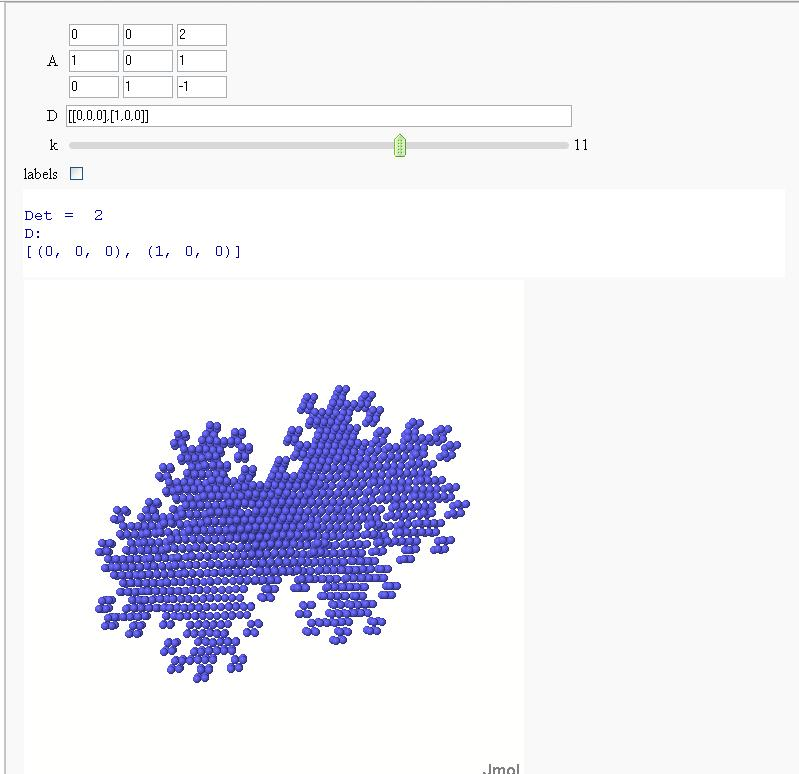

Exploring Mandelbrot
Pablo Angulo
%cython
import numpy as np
def mandelbrot_cython(float x0,float x1,float y0,float y1,int N=200, int L=50, float R=3):
'''returns an array NxN to be plotted with matrix_plot
'''
cdef complex c,z
cdef int h, i, k
m= np.zeros([N,N], dtype=np.int)
for i in range(N):
for k in range(N):
c=complex(x0+i*(x1-x0)/N, y0+k*(y1-y0)/N)
z=complex(0,0)
h=0
while (h<L) and (abs(z)<R):
z=z*z+c
h+=1
m[i,k]=h
return m@interact
def showme_mandelbrot(x0=-2, y0=-1.5, side=3.0,N=(100*i for i in range(1,11)), L=(20*i for i in range(1,11)) ):
time m=mandelbrot_cython(x0 ,x0 + side ,y0 ,y0 + side , N, L )
time show(matrix_plot(m))